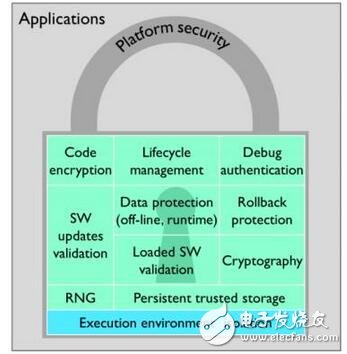Focus:
  · Based on ARMv8-M architecture of ARM Cortex-M processors include ARM TrustZone technology.
· The IoT subsystem with ARM CoreLink System IP enables faster, lowest risk chip time-to-market.
· TrustZone CryptoCell technology helps strengthen secure SoC design.
· Complete wireless solution with ARM Cordio radio IP, supporting 802.15.4 and Bluetooth 5.
· With ARM mbed Cloud, cloud services can support the secure management of IoT devices.
· ARM ArTIsan IoT POP IP is optimized for the TSMC 40ULP process.
ARM has launched the most comprehensive product portfolio for the Internet of Things (IoT), bringing its security, performance, low-power connectivity and device lifecycle management to a new level. With new processors, radio technologies, subsystems, end-to-end security, and cloud service platforms, ARM is committed to accelerating the global adoption of the Internet of Things.
Pete Hutton, executive vice president and product division of ARM, said: "With the increasing popularity of IoT technology, it is time to launch a complete solution to ensure data security from sensor to server. Last year, ARM partners shipped a total of More than 15 billion ARM-based chips have created new records, many of which are used in the smart embedded arena. ARM technology has become the cornerstone of the Internet of Things, and our goal now is to increase its scale. To this end, we launched today. A unique and comprehensive set of technologies and services for seamless collaboration."
The ARM ecosystem is the industry's most successful IoT collaboration with more than 1,000 partners. ARM's latest technology portfolio will provide the fastest and most efficient way for ecosystems to ensure secure IoT applications from chip to device management on any cloud platform.
Extend the proven TrustZone technology to the Cortex-M processor
The ARM Cortex-M23 and Cortex-M33 are the first embedded processors based on the ARMv8-M architecture, extending the market-proven security foundation ARM TrustZone to the most demanding IoT nodes. The vast majority of the world's top ten MCU suppliers have been licensed for two products or one of them. Key partners include ADI, Microchip, Nuvoton, NXP, Renesas Electronics, Silicon Labs and STMicroelectronics.

The versatile Cortex-M33 features configuration options including coprocessor interface, DSP and floating point calculations for superior performance and energy efficiency compared to the Cortex-M3 and Cortex-M4.
The Cortex-M23 meets the most demanding security requirements of the Cortex-M0+ as a standard for small, ultra-low-power microprocessors.
The new Cortex-M processor is backward compatible with ARMv6-M and ARMv7-M architectures, enabling direct and fast migration, helping to accelerate product development cycles.
· TrustZone CryptoCell-312 enhances SoCs to protect the authenticity, integrity and confidentiality of code and data with a rich set of security features.
Introducing the SoC based on ARMv8-M architecture with the fastest and lowest risk
Through a series of new ARM system IPs optimized for the latest Cortex-M processors, chip design teams can accelerate their time-to-market and apply to a wide range of IoT applications.

· ARM CoreLink SIE-200 has licensed ARM chip partners to provide the interconnects and controllers needed to extend TrustZone to the system.
· By Cortex-M33, CryptoCell and Cordio radio integrated into the software drivers, library security, protocol stacks and mbed OS, ARM CoreLink SSE-200 Things subsystem can shorten the time to market 6-12 months.
LED PCB
As printed circuit board technology has continued to evolve, it has paved the way for the creation of a host of exciting product innovations. A prime example is the development of the PCB for LED lighting. The LED is soldered to the circuit board and features a chip that produces the light when electrically connected. A thermal heat sink and a ceramic base are used to bond the chip.
An LED PCB board tends to generate a high volume of heat, making it difficult to cool via traditional means. Consequently, metal core PCBs are frequently chosen for LED application due to their enhanced ability to dissipate heat. Aluminum in particular is often used to manufacture circuit boards for LED lights. The aluminum PCB typically includes a thin layer of thermally conductive dielectric material that can transfer and dissipate the heat with much greater efficiency than a traditional rigid PCB.
PCB LED Applications
PCB LED lights can be incorporated into numerous lighting applications due to their combination of excellent energy efficiency, low cost and maximum design flexibility. Examples include Automotive headlights, Airport runway landing lights, Lighting used in military field applications, Street lighting, Highway tunnel lighting, Photovoltaic (solar) lighting, Flashlights and lanterns, Traffic and signal lighting, Lighting in hospital operating rooms, High growth plant lighting and many others.
LED PCB,LED Circuit Board PCB,Aluminum LED PCB,LED Display PCB
Storm Circuit Technology Ltd , https://www.stormpcb.com